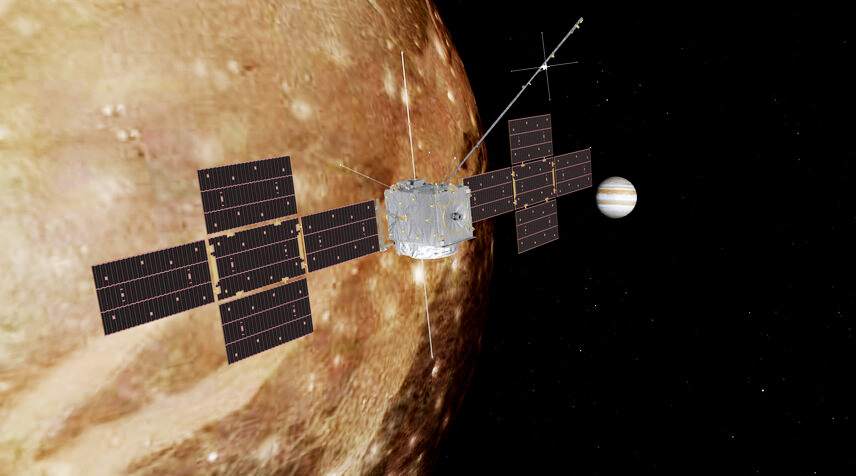ESA’s Jupiter Icy Moons Explorer (JUICE) lifted off on an Ariane 5 rocket from Europe’s Spaceport in French Guiana today (14 April). The successful launch marks the beginning of an ambitious voyage to uncover the secrets of the ocean worlds around giant planet Jupiter.
Following launch and separation from the rocket, ESA’s European Space Operations Centre (ESOC) in Darmstadt, Germany, confirmed acquisition of signal via the New Norcia ground station in Australia and the spacecraft’s vast 27 m long solar arrays unfurled into their distinctive cross shapes, ensuring Juice can travel to the outer Solar System. Completion of this critical operation marked the launch a success.
The orbiter is designed to explore Europa, Ganymede and Callisto, three of Jupiter’s largest moons. It will make two close passes by Europa and 12 by Callisto during the first phase of its mission, from 2031 to 2034, and then orbit Ganymede for the remainder of its mission.
While Ganymede may seem like an unconventional choice – Jupiter’s smaller moon Europa is commonly regarded as more likely to have the right conditions for life – it is the largest moon in the solar system, making it relatively easy to reach and orbit. Like Europa and Callisto, it is thought to have a liquid ocean beneath its icy shell.
Speaking from the launch site, Josef Aschbacher, ESA’s Director general, said: “This is one of the most exciting missions we have ever flown in the solar system and by far the most complex.
“Juice’s spectacular launch carries with it the vision and ambition of those who conceived the mission decades ago, the skill and passion of everyone who has built this incredible machine, the drive of our flight operations team, and the curiosity of the global science community.
“Together, we will keep pushing the boundaries of science and exploration in order to answer humankind’s biggest questions.”
There's good evidence that Jupiter’s icy worlds - Callisto, Europa and Ganymede - hold oceans of liquid water at depth and ESA’s mission aims to establish whether the moons might also have the conditions needed to sustain life.
JUICE, a €1.6 billion (£1.4 billion) mission, is not seeking to detect actual life but it could help determine whether conditions on hidden oceans on each of the moons have at least a chance of supporting simple microbial organisms.
The Ariane 5 launcher did not have the capacity to send the truck-sized spacecraft directly to Jupiter and instead has despatched the spacecraft on a path around the inner Solar System which will include a series of flybys of Venus and Earth to act as gravitational slingshots to propel the mission out to its intended destination. Arrival in the Jovian system is expected in July 2031.
JUICE is the last ESA space science mission to launch on an Ariane 5, the culmination of a legacy dating back to 1999 with the launch of XMM-Newton, which is still in operation today, and most recently, the NASA/ESA/CSA James Webb Space Telescope in 2021.
“What a magnificent demonstration of Europe’s capacity to dream big and deliver results to match,” says Daniel Neuenschwander, ESA’s Director of Space Transportation. “We can all be proud of Ariane 5 for making possible missions like Juice and setting such a high standard for our new generation of launch systems.”
Over the next two-and-half weeks JUICE will deploy its various antennas and instrument booms, including the 16 m long radar antenna, 10.6 m long magnetometer boom, and various other instruments that will study the environment of Jupiter and the subsurface of the icy moons.
Europe’s JUICE begins its long journey to Jupiter











